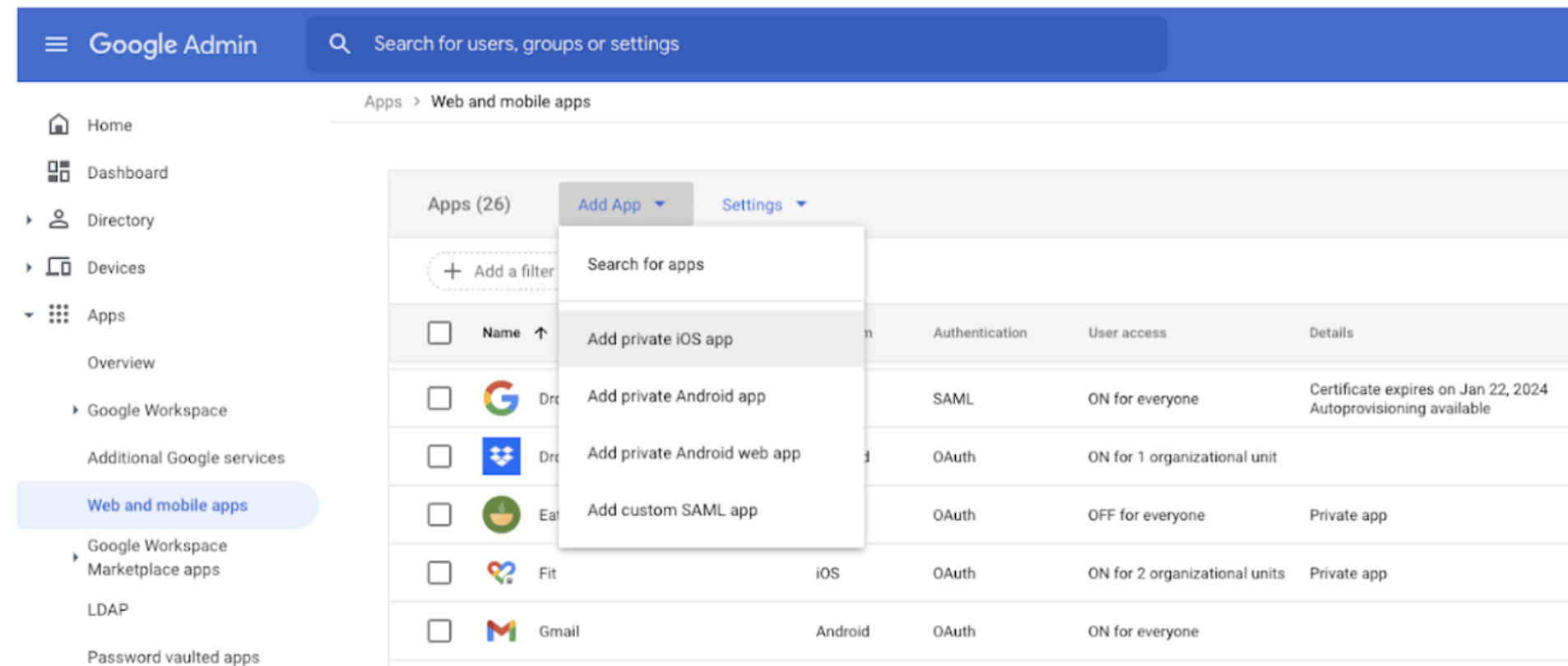Contents:
When exploring Ivanti alternatives and competitors, adopting a UEM solution is crucial for managing multiple devices and operating systems across your organization’s networks.
In this article, we are going to walk you through the top Ivanti alternatives, discussing the pros, cons, pricing, features, and more. Enjoy!
Best Ivanti Competitors and Alternatives – Top 10
Here’s a rundown of the best Ivanti alternatives.
1. Heimdal®
Heimdal®’s Extended Detection and Response (XDR) is a robust cybersecurity solution designed to provide comprehensive and integrated protection against advanced cyber threats.
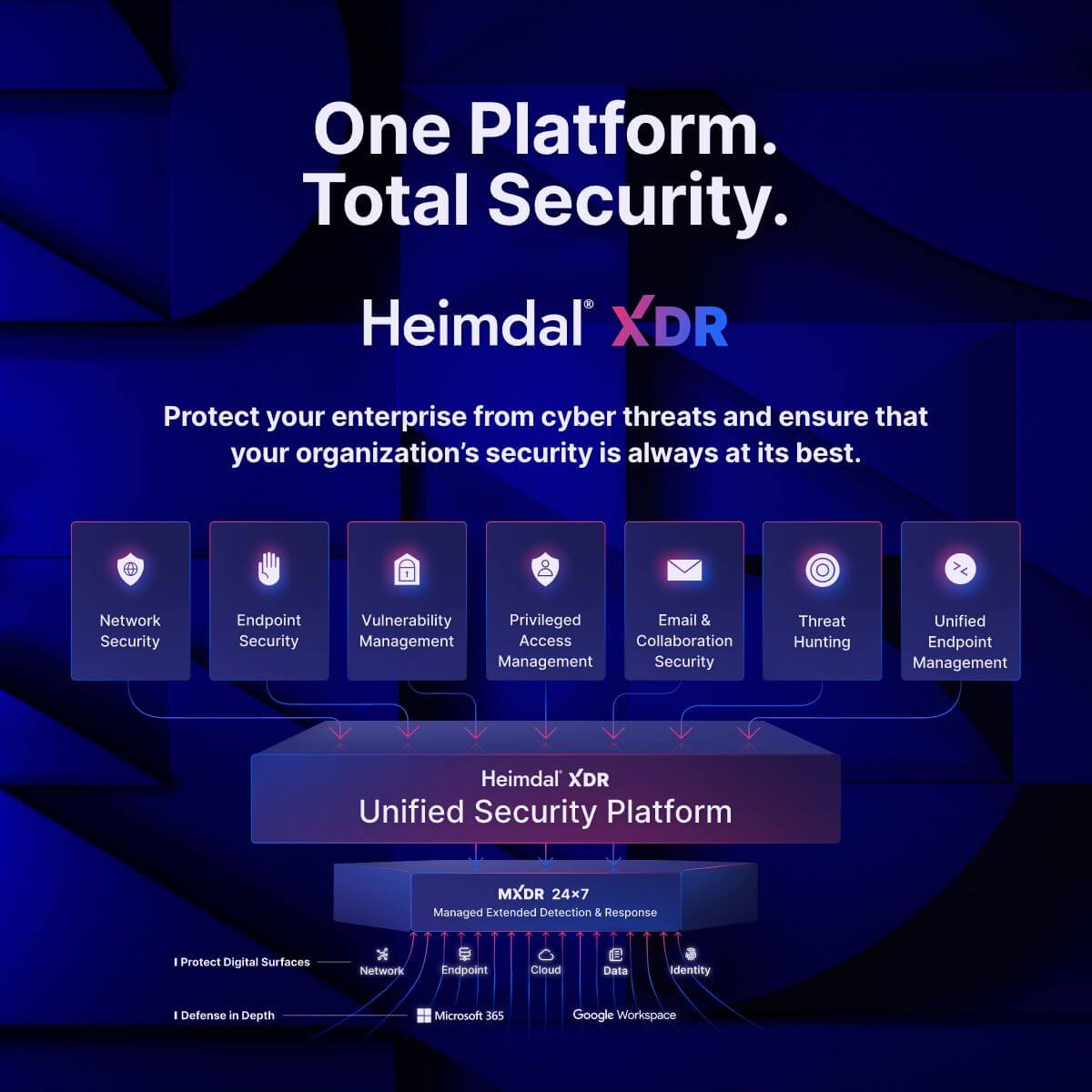
Heimdal offers many different modules in their product, but you can mix and match them as you like so you don’t have to pay for something you’re not going to use. It is also very easy to manage and implement most things in Heimdal.
Christian S., System Administrator
Solid security foundation product with a wide selection of features without being a drag to your system. We use almost every feature and we evaluate them before buying them.
I like the online management, the complete package of all security applications needed, all-in-one place. Easy to search and filter logs and get information about clients welfare.
Key Features
- Next-Gen Threat Intel. Supplies advanced threat intelligence, advanced forensics details, and more, using AI/ML predictive models, Extended Threat Protection (XTP) detection engine, and MITRE ATT&CK techniques.
- Intelligent Insights. Provides definitive arbitrary heuristics without false positives, pre-scored and fully contextualized for various operations(hunting, investigations, audit trails, or reporting).
- Integrated Threat Hunting. Features precomputed risk scores, indicators, and detailed attack analysis.
- Automated Remediation & Response. Features an action center that allows for seamless and efficient one-click automated and assisted actioning across the digital enterprise.
Pros
- Unified approach. A single platform combines all your needs, including vulnerability management, patch management, privileged access, network security, and firewalls to name a few.
- Wide functionality. Traditional RMM functionality paired with a broad range of cybersecurity features.
- No 3rd-party support. All customers have a single dedicated contract for support.
- Privileged Access Management. A single platform to access privileged access management (PAM), privilege elevation and delegation management (PEDM), and session management application control (SMAC).
- Threat hunting. Detect the biggest weaknesses in your environment and manage real-time security events.
Cons
- Hardware. Heimdal® currently lacks some functionality to manage hardware insights and alerts.
Pricing
Heimdal® offers custom pricing based on your needs.
Get in touch with us, book a demo, and one of our representatives will take care of you and discuss all the details.
Ready to experience the cutting-edge of cybersecurity with Heimdal? Book a demo now!
2. ConnectWise Automate
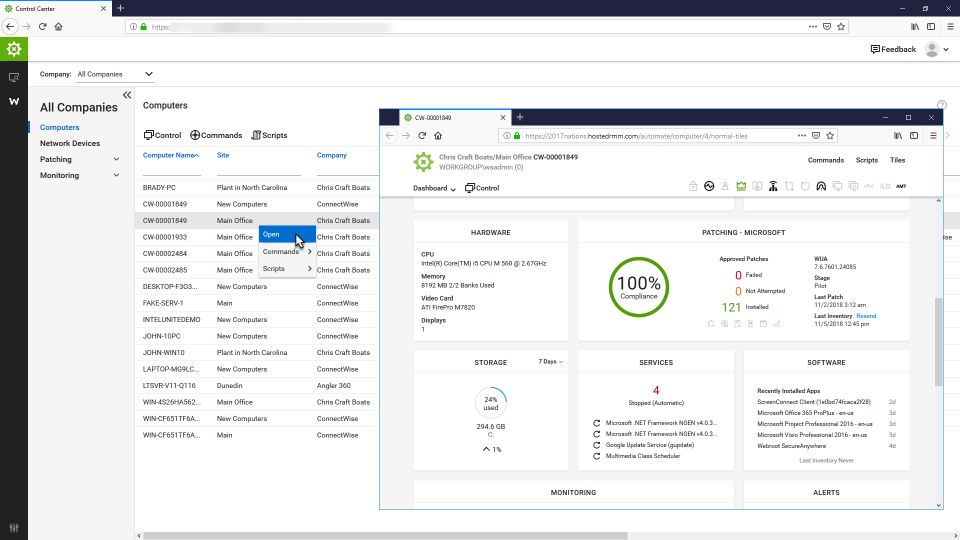
ConnectWise Automate is a robust Remote Monitoring and Management (RMM) software designed to proactively monitor, manage, and support client networks.
The platform is engineered to facilitate IT professionals in delivering exemplary and automated services to their clientele.
Key aspects include Asset Discovery, Patch Management Automation Software, Remote Monitoring, and IT Automation.
Key Features
- Automated patch management for third-party applications.
- Easy setup.
- Automated maintenance. auto time entries and “out-of-the-box” script functions.
- Administrative task delegation for emailing scheduled reports, generating random passwords, running SQL queries, or updating custom data fields.
- Agentless remote management for Telnet- and SSH-enabled devices (e.g., IoT hardware, firewalls, switches, routers).
- Remote session auditing.
- Protection against data breaches.
Pros
- Integrations. ConnectWise Automate offers a broad range of integrations with 3rd-party providers, as well as other ConnectWise products.
- Strong functionality. The product has a comprehensive set of RMM scanning and support features, comparing well to other competitors in the market.
- Consolidated approach. ConnectWise brings automation, support, networking, and more into a unified IT platform.
Cons
- User interface. User reviews suggest that the ConnectWise platform can be difficult to use and the UI is not as intuitive as other competitors.
- Learning curve. The breadth of functionality in the platform can make it difficult for users to quickly get to grips with.
- Patching and reporting. These features are often cited by users as a drawback, with the product lacking robust patch reporting and data views.
Pricing
- On-premises: $1 – $6 per month/per agent.
- On-Premises: $700 implementation fee.
Testimonials
ConnectWise Automate Pros
+ 1. Single central patch management system.
2. Customized policy for specific (dynamic ) needs.
3. Endpoint Management (incredibly remote connect) for support.
4. Distribute software remotely on specific time deployment.
ConnectWise Automate Cons
– My only real complaint is sometimes the data isn’t current and you have to poll for updated information from the endpoint. but this is due to the timing of the polling and the workload of the server.
Jason W., NOC & SOC Team Lead – Senior Data Center Network & Telephony Engineer
3. Atera

Atera offers an all-in-one IT platform providing remote monitoring and management of unlimited devices at a fixed cost.
Features include instant remote access via various platforms, AI-powered helpdesk, and ticketing, network discovery with real-time security scans, and patch management automation software for Windows, Mac, and Linux.
The platform aims to enhance IT environments and significantly boost team efficiency.
Key Features
- Application performance management: virtualization monitoring and IT asset discovery.
- Monitoring: remote monitoring, network device monitoring, and activity monitoring.
- Management tasks: patch management and policy-based automation.
- Remote access: attended device access, unattended device access, mobile device access, virtual device access, multiple-display support, and multiple concurrent sessions.
Pros
- Flawless RMM integration.
- Seamlessly create remote work plans.
- Ease of use.
- Comprehensive support.
Cons
- No multimon support in Splashtop.
- Steep learning curve for scripting and patching tools.
Pricing
- MSP – Pro: $99 per month per user (cloud only).
- MSP – Growth: $129 per month per user.
- MSP – Power: $169 per month per user.
- IT Department – Professional: $149 per month per user.
- IT Department – Expert: $169 per month per user.
- IT Department – Master: $199 per month per user.
Testimonials
Atera Pros
+ All-in-one tool.
Can access all the devices.
Can get the current status.
Remote connection via splashtop is fast enough and works in login computer login screen ( Compared to Anydesk ).
Doesn’t Loose connection after restart (No user intervention required).
Atera Cons
Tried installing some media software to one of our remotely located desktop which is connected to Atera through the agent but we were unable to do it as it threw unexpected error and there was no specific issue mentioned which would eventually help us to troubleshoot.
Same issue happend while tried to create custom script to remote desktop
. I would suggest to add detailed error messages/log which would help the administrator to troubleshoot this type of issues.
4. N-able N-sight RMM

N-able N-sight RMM provides a comprehensive remote management solution, offering remote access, ticketing, and billing in one platform.
It features monitoring alerting, patch management for various OS, patch management automation software with preconfigured scripts, robust Apple support, secure remote access, ticketing and more.
It aims to empower IT professionals with a tool that combines functionality and security, ensuring efficient remote IT management.
Key Features
- Cross-platform compatibility (i.e., Windows, macOS, and Linux).
- Complex dashboard with a user-friendly interface.
- Monitoring. Online status, check results, task completion, memory & performance stats, hardware & software details, antivirus, patch status (e.g., missing patches).
- Asset inventory. Add or remove devices, custom device(s) view, export to Excel, build complex filters.
- Monitoring agent. Fetch device details, and hardware & software assets, check results, and schedule automated tasks.
Pros
- Easy to deploy.
- Ease of use.
- Scheduled AV Scan.
- AV Management.
Cons
- Pricing.
- Support.
- Lack of integration options.
Pricing
Starting at $99 for 3 users.
Testimonials
N-able N-sight RMM Pros
+ Its a single pane of glass that I am able to manage all aspects of my business. I am a small business computer consultant from San Diego who specializes in working with clients that are 25 users and under. As a one man shop, I have to do everything myself. N-Able allows me to take care of it all.
N-able N-sight RMM Cons
– Rmm from time to time gets buggy and standard chat request don’t process on the clients screen at times. That’s not the only bug I’ve experienced, but the only one I can remember at this time.
5. Microsoft Intune
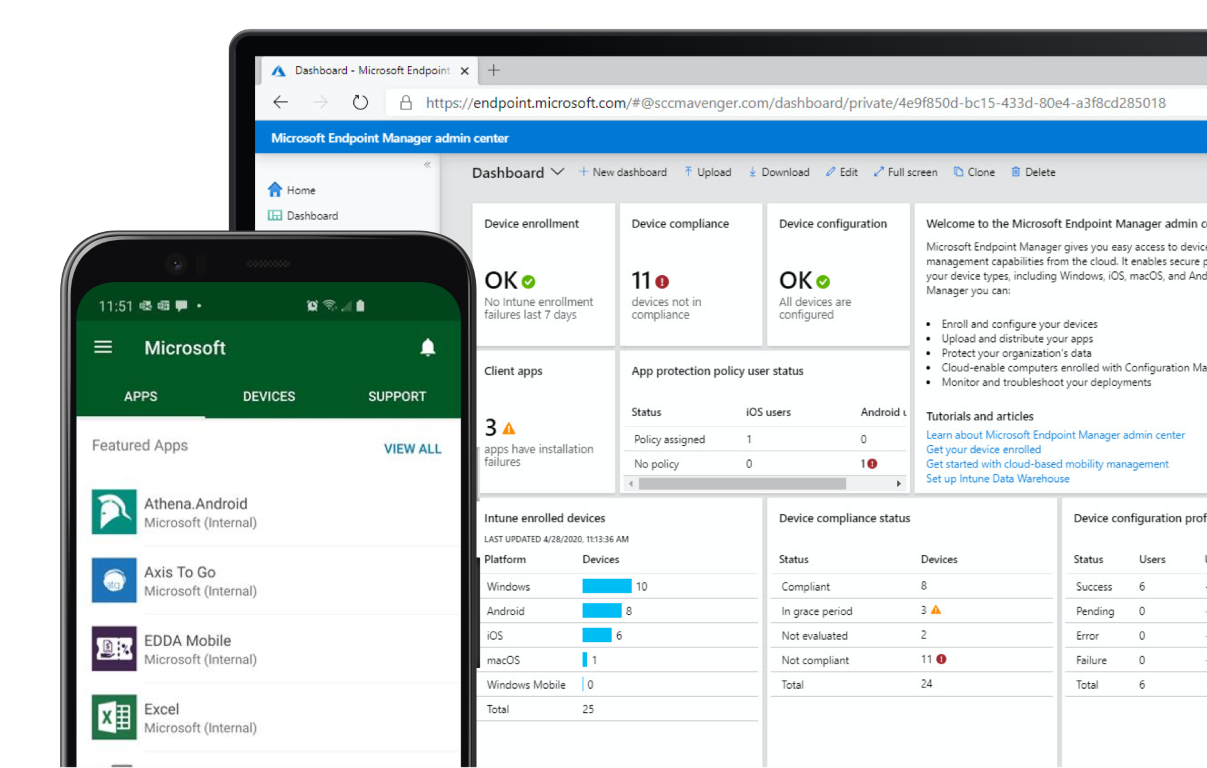
Microsoft Intune is a cloud-based endpoint management solution designed to manage users’ access, apps, and devices across various operating systems.
It ensures secure access to organizational resources, simplifies app and device management, and supports compliance and reporting features, adhering to the zero-trust security model.
Key Features
- Advanced Group Policy Management.
- System Center error desktop monitoring.
- Enterprise desktop virtualization.
- Asset inventory services.
- App-V.
- Device management for company-owned and personal devices (e.g., BYODs).
- Cross-platform compatibility.
Pros
- Segregation of corporate and personal data.
- Seamless integration with non-Windows software & devices.
- Data Loss Protection (DLP).
Cons
- Non-intuitive user interface.
- No in-app remote connection features.
Pricing
- Microsoft 365 Business Basic – $5 per user per month (On-premises).
- Microsoft 365 For Individuals – $6.99 per month (On-premises).
- Microsoft 365 Apps – $8.25 per user per month.
Testimonials
Microsoft Intune Pros
+ Easy rollout of software to groups of computers.
The advantage is that you do not have to go on site to install software manually. I use Microsoft Intune together with the endpoint manager to roll out complete systems including all software without having to intervene.
Microsoft Intune Cons
– While Intune integrates well with other Microsoft services, some users may find that third-party integrations are more limited compared to other UEM solutions.
The cost of Intune licensing may be a concern for some organizations.
The extensive range of policy options in Intune can be overwhelming, leading to challenges in configuring and fine-tuning policies.
6. IBM Security MaaS360

IBM MaaS360 is a UEM solution that provides the ability to manage and secure users, smartphones, tablets, laptops, and apps, ensuring data security and compliance while maintaining workforce productivity.
Key Features
- Transform how IT protects various devices including laptops, desktops, smartphones, tablets, wearables, and IoT devices.
- Ensure a seamless experience while protecting devices, apps, content, and data.
- Rapidly scale remote workforce and BYOD initiatives.
- Build a zero-trust strategy for various scenarios (e.g., change management, service management. etc).
- Utilize contextual analytics from AI for actionable insights.
- Scale and integrate with existing infrastructure and investments.
- Manage laptops, desktops, mobile devices, wearables, IoT, and ruggedized devices.
Pros
- Advanced defense against phishing and Man-in-the-Middle (MITM) attacks.
- Support for BYODs.
- Ability to connect with on-prem AD via dedicated cloud connector.
Cons
- Incompatible with T-Mobile.
- Unintuitive authentication mechanisms.
- Unintuitive user interface.
Pricing
- Essentials – $4 per client (Cloud).
- Deluxe – $5 per client (Cloud).
- Premier – $6.25 per client (Cloud).
Testimonials
IBM Security MaaS360 Pros
+ Its simplicity of use and connection with the devices, as well as the quantity of options and rules that can be applied to the devices, made the entire deployment and configuration management process quite simple.
I really liked the interface and the panels.
We were able to get control of the mobile devices and apply security controls to them; the security provided by the system is excellent, and we can manage many devices and endpoints with ease.
It allows for high volume uploads by users and the addition of a large number of devices.
Additionally, the geotagging tool is excellent and provides a wide variety of security measures.
IBM Security MaaS360 Cons
– What I dislike about IBM Security is it’s taking too long to delete a user from the user admin side, this is something that I am not sure of and may also have to do with how it is setup from our side.
7. Citrix Endpoint Management

The solution provides UEM technology designed to create an optimal workspace experience, allowing employees to work flexibly while ensuring secure and organized management of all apps, devices, and platforms centrally.
It emphasizes enhancing productivity, reducing support calls, and ensuring security and compliance across all endpoints, offering a cloud-based solution with a 99.9% uptime SLA and automatic updates for a seamless experience.
Key Features
Citrix’s software suite encompasses MDM, MAM (i.e., Mobile Application Management), and hybrid (i.e., MDM + MAM) features.
- Device enrolment support.
- Domain authentication support.
- Domain plus security token authentication support.
- Client certificate authentication support.
- Client certificate plus domain authentication support.
- Client certificate plus security token support.
- Azure AD identity provider support.
Pros
- Low Total Cost of Ownership (TCO).
- Complete data and password sync.
- SecureWeb Xenmobile eliminates the need to deploy a VPN.
Cons
- Increased difficulty in deploying across multiple mobile operating systems.
- Setup can be challenging.
- Troubleshooting logs are hard to read.
Pricing
- Standalone – $4 per client per month or $3 per device per month.
- Workspace Premium – $18 per client per month.
- Workspace Premium Plus – $25 per client per month.
Testimonials
Citrix Endpoint Management Pros
+ Easy to connect, Safe double authentication requirement, and an upgradable interface to add banking applications depending on the level of the user.
Much better than competitors as it does not consume much space on the system and offers full access to the mainstream environment sitting from home.
Citrix Endpoint Management Cons
– While using this software, retaining the application wrapping process can be quite tricky.
It is quite slow in its updates to keep compliance with the user end.
It needs integrations with a lot of external applications and third parties to get some of its features functioning otherwise its compatibility with some applications may prove to be complex.
So, using a lot of external integrations can make this software resource extensive.
8. KACE Systems Management Appliance
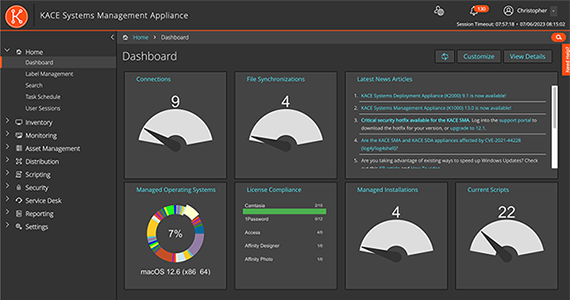
The Quest KACE Systems Management Appliance provides a comprehensive IT systems management solution, enabling automated administrative tasks for all network-connected devices. Key features include inventory of hardware and software, patch management, vulnerability management tools, IT asset management, and software license compliance.
Key Features
- Secures endpoints with tools like patch and vulnerability management.
- Inventories all hardware and software for comprehensive endpoint security.
- Blocks dangerous or unnecessary software and devices.
- Patches and updates mission-critical applications and operating systems.
- Provides visibility into software usage for better resource allocation.
- Provides tools for agent troubleshooting, especially for issues like agents not checking in or not running inventory.
- Automates services such as desk ticket management for better efficiency.
- Supports cloud-based off-board backups such as Microsoft Azure Blob and Amazon S3 storage.
Pros
- Comprehensive knowledge base.
- Intuitive interface.
- Easy integration with multiple devices & software.
Cons
- Frequent logouts.
- Difficulty in patching certain applications.
- Not HTML5-friendly.
Pricing
On-demand pricing. For additional information, contact the vendor.
Testimonials
KACE Systems Management Appliance Pros
+ Pretty much all of the features are valuable. The inventory is very helpful to be able to keep track of our devices.
The deployments make it easy to deploy new software packages or upgrade packages.
The help desk is also a great tool for tracking problems and problem tickets.
Scott Baxter, Technical Support Engineer at City of Rochester
KACE Systems Management Appliance Cons
– The initial setup was complex. It is a Linux-based virtual server, where the customer cannot get into the back-end, so you can only follow their prompts.
Then, there are specific things that have to be done in their implementation and upgrade phases that have to be done in a certain order or steps.
If you don’t get those steps right, the system doesn’t work.
I think that either simplifying that process or providing really good step-by-step documentation would be helpful.
9. Google Endpoint Management
The solution is designed to manage and secure devices, ensuring secure access to resources regardless of client location.
It provides features like MDM, enforcing security settings, managing updates, service management, and ensuring secure access to apps, all without impacting user productivity.
Key Features
- Basic passcode enforcement (mobile).
- Google Credential Provider for Windows.
- Basic MDM.
- Fundamental management for computers.
- Endpoint verification.
- Drive for desktop.
- Block devices.
- Remote account wipe (mobile).
- Remote sign-out (computers).
- Public and private Android application curation.
- Basic mobile device and endpoint details.
- Device reports.
- Company-owned inventory: computers.
Pros
- Wireless network support systems.
- Perform update or software deployment from Google Endpoint.
- Advanced data management.
Cons
- No online templates, battlecards or playbooks.
- Poor customization features.
- Takes up too much disk space.
Pricing
- Google Workspace – Business Starter: $6 per client per month (Cloud).
- Google Workspace – Business Standard: $12 per client per month.
- Google Workspace – Business Plus: $18 per client per month.
Testimonials
Google Endpoint Management Pros
+ Google Endpoint Management is a wonderful device management solution to simplify the solution of different devices within an organization.
It has a very user-friendly interface and amazing features for businesses of all sizes.
It seamlessly integrates with the Google ecosystem.
Google Endpoint Management Cons
– I wish there were more individualized policies as opposed to global ones. sometimes we need to isolate a group or individual but policy changes only allow global changes.
10. Cisco Meraki Systems Manager
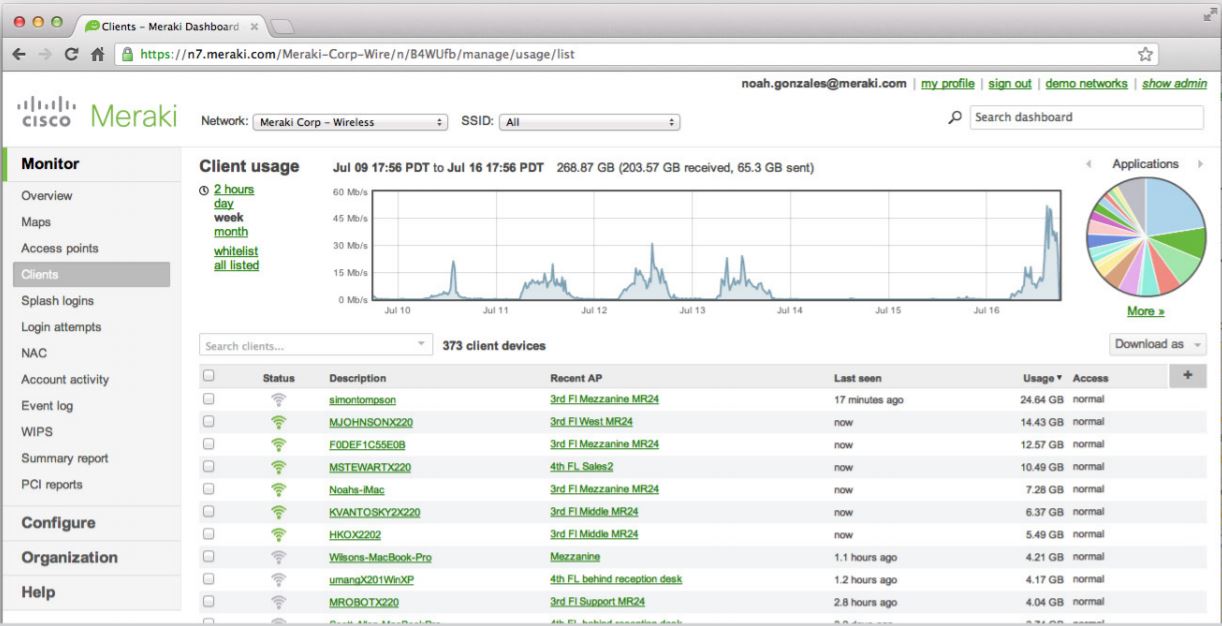
Cisco Meraki Systems Manager offers a cloud-first solution for mobile MDM, ensuring secure and seamless remote management of devices with agility.
The platform enables automatic configuration imports, real-time monitoring, and remote remediation.
Key Features
- Managed via the web with Meraki’s secure browser-based dashboard.
- Organization-level two-factor authentication.
- Role-based administration.
- Inventory data export to CSV.
- Enforce passcode policies and failed entry device wipe policy (Android, iOS, Mac, PC).
- Scan client device for Systems Manager before allowing network access (Android, iOS, Mac, PC).
- Simple Certificate Enrolment Protocol (SCEP).
- Customer Certificate Signing for certificate provisioning.
Pros
- Advanced policy management.
- Provisioning features for mobile devices.
- Integration with Apple Device Enrollment program.
Cons
- Compatibility issues with some devices.
- Poor encryption.
- No real-time tracking feature.
Pricing
On-demand pricing. For additional information, contact the vendor.
Testimonials
Cisco Meraki Systems Manager Pros
+ Ease of use and dashboard experience. Very easy to configure and is user friendly in making configuration changes on the fly. Zero touch deployments ake it easy to send equipment to the client directly and deploy through the cloud control.
Cisco Meraki Systems Manager Cons
–You don’t have direct access to CLI, there’s a lack of advance troubleshooting, dashboard has its latency to show real time information.
Frequently Asked Questions (FAQ)
1. What is Ivanti Endpoint Manager?
Ivanti Endpoint Manager is a centralized solution for managing and securing endpoints, including desktops, laptops, servers, mobile devices, and virtual machines.
2. What features does Ivanti Endpoint Manager offer?
Ivanti Endpoint Manager offers patch management, software distribution, remote control, endpoint security, asset management, and configuration management from a single console.
3. How does Ivanti Endpoint Manager enhance security?
It improves security through vulnerability management, patching, antivirus management, and endpoint protection, ensuring compliance and safeguarding against threats.
4. Can Ivanti Endpoint Manager support remote and mobile devices?
Yes, it supports remote and mobile devices, facilitating management and security enforcement regardless of location.
5. Is Ivanti Endpoint Manager suitable for businesses of all sizes?
Yes, Ivanti Endpoint Manager scales to meet the needs of small to large enterprises, offering flexibility and adaptability.










 Network Security
Network Security
 Vulnerability Management
Vulnerability Management
 Privileged Access Management
Privileged Access Management  Endpoint Security
Endpoint Security
 Threat Hunting
Threat Hunting
 Unified Endpoint Management
Unified Endpoint Management
 Email & Collaboration Security
Email & Collaboration Security




